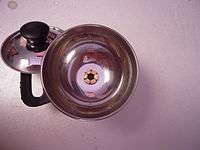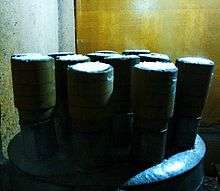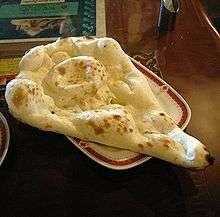Puttu
|
Puttu | |
| Course | Breakfast |
|---|---|
| Place of origin | Sri Lanka & India |
| Region or state | India (in Kerala, border regions of Tamil Nadu, Kanara region of Karnataka), Sri Lanka, Singapore, Malaysia (as putu bambu), Philippines (as puto bumbóng) and Indonesia (as kue putu) |
| Main ingredients | Rice flour, coconut |
|
| |
Puttu pronounced [ˈputtu], (Malayalam: പുട്ട്), (Tamil: புட்டு), (Sinhala පිට්ටු ) is a breakfast dish highly popular in Kerala also available in border regions of Tamil Nadu , Kanara region of Karnataka and Sri Lanka. Puttu or pittu is a word of Tamil origin which means "portioned". It is made of steamed cylinders of ground rice layered with coconut. It is highly popular in the Indian state of Kerala as well as in many areas of Sri Lanka, where it is also known as pittu. Puttu is served with side dishes such as palm sugar or chickpea curry or banana. In Bhatkal Puttu is served with side dishes such as ghee and sugar or Paya or mutton curry.

Ingredients
Puttu principally consists of coarsely ground rice, grated coconut and water. It is often spiced with cumin, but may have other spices. The Sri Lankan variant is usually made with wheat flour or red rice-flour without cumin whereas the Bhatkal recipes have plain coconut or masala variant made with mutton or shrimp flavoured grated cocunut.[1]
Preparation
Puttu is made by slowly adding water to ground rice until the correct texture is achieved. It is then spiced, formed and steamed with layers of grated coconut.
Puttu is generally cooked in a metal puttu kutti vessel with two sections. The lower section holds water and the upper section holds the puttu — where the rice mixture is inserted with layers of grated coconut. Perforated lids separate the sections to allow the steam to pass between them.
A number of alternative cooking vessels are used, such as traditional vessels where a perforated coconut shell is attached to a section of bamboo, or a chiratta puttu made of a coconut shell or of metal shaped similarly to a coconut shell.

Other types of cooking vessels include a pan similar to an idli pan with small holes in the bottom, pressure cookers and, mainly in the Malay Archipelago, hollow bamboo stalks.
Serving
Puttu is often served along with gravies, like fish curry, chicken curry or kadala (chickpea) curry, and papadum. Also plantain, jackfruit, mango or banana is commonly served with it. In some areas of Kerala people eat puttu accompanied by sweet black coffee. In Tamil Nadu it is served with grated coconut with jaggery made of palm or sugar cane, or with sweetened coconut milk. In Sri Lanka, pittu is usually accompanied with tripe curry, fish or a meat curry, coconut milk and a sambol.
Variations

Some variations of puttu use other grains such as wheat flour, tapioca and corn flour. The layered filling of coconut can be replaced by other foods, such as egg curry or banana. Puttu prepared in a ball shape are called manipputtu. Puttu can also be made using bamboo rice
In Maritime Southeast Asia, the most popular puttu variant is bamboo-steamed puttu, known as common kue putu in Indonesian, putu bambu in Malay, and puto bumbóng in Tagalog. It consists of rice flour with green pandan leaf coloring, cooked with palm sugar filling, steamed in bamboo pipes, and served with grated coconut flesh. In Indonesia, kue putu is commonly found being sold by travelling vendor cart together with klepon, which is actually ball-shaped kue putu.

Puttu is also very common in Mauritius. It is usually sold by hawkers and is served as a snack. It is often misspelled poutou and should be spelled putu in Mauritian creole.[2] The ingredients are the same; rice flour, sugar and desiccated coconut but cooked in metal cylinders.
World record attempt
In 2006, students of the Oriental school of Hotel Management in Wayanad in north Kerala made a 10 foot long puttu. They cooked the giant puttu in a specially designed 12 foot long aluminium mould, using 20 coconuts and 26 kg of powdered rice. It took about one and a half hours to cook.[3]
See also
- Tamil cuisine
- Cuisine of Kerala
- Sunga Pitha, Assamese dish similar to Puttu
- Puto
- List of steamed foods
References
- ↑ "BBC Indian Food Made Easy: Recipe for puttu", BBC, retrieved 2010-08-13
- ↑ http://www.lalitmauritius.org/dictionary.php?wrd=putu
- ↑ "Kerala's Hotel Management Students Cook Up World Record Puttu", Indiatourism, retrieved 2010-10-22
External links
| Wikimedia Commons has media related to Puttu. |
| Wikibooks Cookbook has a recipe/module on |
.jpg)


